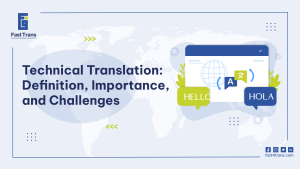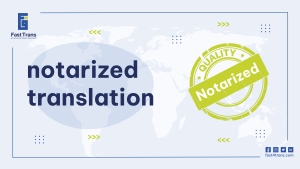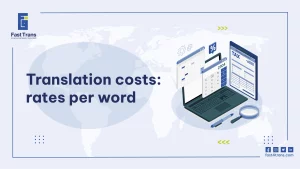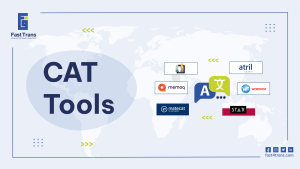Arabic financial translation ensures accurate and culturally relevant communication of financial documents like reports, invoices, and tax statements for Arabic-speaking markets. It requires a deep understanding of both financial terminology and regional regulations to avoid errors that could lead to costly consequences.
As businesses expand into Arabic-speaking regions, this specialized translation helps ensure compliance, transparency, and effective communication, fostering stronger relationships and a solid reputation in the market.
What is Arabic Financial Translation?
Let’s first take a look at the definition of this field.
Arabic financial translation is a specialized field of translation that requires a solid grasp of both the source and target text languages, along with a deep understanding of financial matters and the tone of financial documents.
An Arabic financial translator may be hired to translate various documents, including tax reports, stock market analyses, retirement plans, and bank statements, ensuring accuracy and cultural relevance.
Arabic financial translation is particularly essential for international corporations operating in Arabic-speaking countries. When companies expand into the Arab world or partner with Arabic-speaking firms, they must have financial agreements translated to ensure clear and effective communication with all involved parties.
Importance of Arabic financial translation services
One question businesses expanding into Arabic-speaking markets often ask is: How can they effectively communicate with the needs, laws, regulations, and demands of the new market? The answer to this lies in Arabic financial translation and localization.
Financial texts such as business plans, contracts, purchase orders, bonds, audit reports, and more cannot be trusted to AI-powered online translation tools like Google Translate. They must be handled by an experienced translator with an eye for detail, particularly when translating into Arabic, as it involves nuances that require cultural and linguistic expertise.
When done correctly, the translation of financial texts into Arabic can contribute to better communication between enterprises, increased revenue, and an enhanced reputation in the Arab market.
Types of Arabic financial translation services
Arabic financial translation covers various areas like accounting, corporate, insurance, real estate, and manufacturing, ensuring accurate and culturally relevant communication for Arabic-speaking clients. It involves translating documents such as invoices, financial statements, policies, and reports with precise financial terminology tailored to regional nuances.
1. Accounting
a. Invoice translation (ترجمة الفواتير):
A bill from the seller to the buyer that details the purchased product’s information such as price and quantity, with a need for accuracy in translating terms for Arabic-speaking clients.
2. Corporate
a. Annual reports translation (ترجمة التقارير السنوية):
A financial report analyzing a company’s yearly performance. The translation must consider the cultural and regional nuances of Arabic-speaking investors.
b. Balance sheets translation (ترجمة بيانات الميزانية):
A snapshot of a company’s financial position at a particular point in time, requiring precise terminology and financial language tailored for the Arabic market.
3. Insurance
a. Insurance policies translation (ترجمة وثائق التأمين):
A contract that details what the insurer is promising to cover, needing accurate translation to ensure clarity for Arabic-speaking policyholders.
b. Financial statements translation (ترجمة البيانات المالية):
Formal accounts of financial activities, translated to ensure Arabic clients or stakeholders fully understand financial performance.
c. Compliance documentation translation (ترجمة وثائق الامتثال):
Documents confirming that an organization meets legal and regulatory standards, with careful attention to the correct use of Arabic legal and financial terminology.
4. Real Estate
a. Income statements translation (ترجمة بيانات الدخل):
An important document showing how a company performed financially, with translation nuances that cater to Arabic real estate investors and companies.
b. Property listings translation (ترجمة قوائم العقارات):
Translations of property listings, whether online or offline, ensuring they are accurate and culturally appropriate for the Arabic-speaking real estate market.
5. Manufacturing
a. Expense reports translation (ترجمة تقارير النفقات):
Documenting business spending in the production process, translated to ensure clarity in Arabic for businesses that need to track costs.
b. Supply chain documents translation (ترجمة مستندات سلسلة الإمداد):
A variety of documents required throughout the production and distribution process, such as invoices or insurance certificates, all translated for Arabic-speaking stakeholders.
Other types of financial translation:
- SEC reports translation (ترجمة تقارير لجنة الأوراق المالية والبورصات): Providing Arabic versions of regulatory filings.
- Business plans translation (ترجمة خطط الأعمال): Tailoring business plans to suit the Arabic-speaking market.
- Cash flow statements translation (ترجمة بيانات التدفق النقدي): Translating detailed cash flow documents into Arabic.
- Fiscal reports translation (ترجمة التقارير المالية): Specialized translation of fiscal documents, adjusted for the Arabic context.
- Bank statements translation (ترجمة كشوف الحسابات البنكية): Translating detailed bank transactions to be understood by Arabic clients.
- Tender documentation translation (ترجمة مستندات العطاء): Translating tender documents that comply with Arabic legal and financial standards.
- Foreign exchange translation (ترجمة معاملات الصرف الأجنبي): Translating foreign exchange-related documents for Arabic investors.
- Tax reports translation (ترجمة تقارير الضرائب): Translating tax-related documents with a focus on Arabic tax laws and regulations.
- Client meetings translation (ترجمة اجتماعات العملاء): Translating meeting notes and contracts for Arabic-speaking clients.
- Retirement plans translation (ترجمة خطط التقاعد): Adapting retirement plans to suit Arabic-speaking markets, ensuring cultural relevance.
- Employee benefit meetings translation (ترجمة اجتماعات مزايا الموظفين): Translating employee benefit documentation and discussions into Arabic.
Each of these types of Arabic financial translation requires not only linguistic expertise but also an in-depth understanding of both regional financial terminology and the cultural context within Arabic-speaking communities.
Challenges of Arabic financial translation
Arabic financial translation faces challenges such as staying updated with evolving regulations, ensuring accuracy in diverse financial contexts, and adapting to regional variations in terminology. The need for consistent language, quick delivery, and precision under tight deadlines further complicates the process.
1. Staying up to date with changing rules and regulations:
In Arabic financial translation, it is crucial for translators to stay informed about the evolving financial regulations, as terminology must align with both international standards and the specific regulations of Arabic-speaking regions.
2. Contextual challenges:
Financial translators working with Arabic must localize and fully understand the specific context of a text, especially considering regional variations in financial practices and terminology across different Arabic-speaking countries.
3. Small mistakes/Huge repercussions:
One of the primary challenges in Arabic financial translation is maintaining accuracy. A single error could have significant legal or financial consequences, especially given the complex regulatory environment in Arabic-speaking countries.
4. Dealing with numbers, symbols, dates, and currencies:
Arabic financial translators face the added challenge of accurately translating numbers, financial symbols, dates, and currencies. Localizing these elements is essential to ensure that the translation meets the expectations of Arabic-speaking audiences.
5. Consistent terminology is essential:
Achieving consistency in Arabic financial translations requires the use of various tools, such as translation memories, term bases, and glossaries. These tools are especially important in Arabic due to the diversity of terms and expressions used in financial contexts across different Arabic dialects.
6. Tight deadlines in a fast-paced market:
Financial translators in Arabic-speaking markets may face demanding deadlines, often needing to deliver accurate translations quickly in a fast-paced financial environment. Efficiency is crucial, but so is precision.
7. Constant adaptation to new emerging markets and terminologies:
As financial markets continue to evolve in the Arab world, translators must constantly adapt to new financial terminology, regulations, and market trends, requiring continuous learning and flexibility.
Key Tips for Better Arabic Financial Translation
Financial translation is far from a mere word-for-word conversion, especially when it comes to Arabic financial translation. It requires an understanding of both market trends and the nuances of the Arabic language. Additionally, continuous improvement of skills is essential to ensure accurate, reliable translations.
Here are 7 key tips every Arabic financial translator should consider, and every company should look for when hiring a professional to handle their Arabic financial documents:
1. Using Translation Tools and Software Wisely
Have you heard of CAT tools? If not, we recommend exploring guides on them to get a solid understanding. CAT tools are crucial for specialized translators, as they increase accuracy, speed, and consistency. For Arabic financial translation, it’s essential to be mindful of which tools to use and how to optimize them. Translation memories and quality assurance features, such as error scanning, are invaluable for maintaining consistency across Arabic texts.
2. Understand the Financial Context
Understanding the context is key. This is especially true for Arabic financial translation, where terminology can vary significantly across regions. Companies should help translators understand the specific financial context to avoid confusion, ensuring both parties are on the same page. Open communication with the financial team is critical to clarifying any ambiguities in financial terms or practices specific to Arabic-speaking countries.
3. Be Up to Date with Rules and Regulations
Keeping track of financial regulations is vital, particularly when translating into Arabic for specific regions like the Gulf, Levant, or North Africa. Financial regulations differ by country, so it’s essential to stay updated with the latest laws in the Arabic-speaking world. This also involves keeping an eye on news and trends in Arabic finance, which can vary widely depending on the region. Subscribing to financial publications in Arabic will help you stay informed.
4. Prioritize Accuracy Over Speed
Accuracy is paramount in Arabic financial translation. You must check everything—currency conversions, date formats, percentages, and numerical conversions—meticulously. In the Arabic language, numerical separators differ; for example, Arabic-speaking countries often use commas instead of periods. Ensuring these details are correct can prevent costly errors. It’s essential to prioritize quality and precision over speed.
5. Colloquialisms or Jargon
When translating for Arabic-speaking audiences, be mindful of the terminology used. While some industry-specific terms are universal, many others may require adjustments depending on the region. Avoid overly complex jargon that may be unfamiliar to Arabic-speaking readers, and always provide clear, simple alternatives when possible.
6. Confidentiality and Data Safety
The importance of confidentiality cannot be overstated in Arabic financial translation. Whether you’re translating documents for a company or an individual, make sure to use secure methods, such as encryption tools. Avoid relying on untrusted online translation tools, as these could compromise sensitive financial information. Consider investing in a Translation Management System (TMS) to keep all documents secure and organized.
7. Maintain a Dynamic Glossary
Financial terminology evolves, especially in the Arab world, where different regions may have varying expressions for the same financial terms. Keeping an updated glossary of Arabic financial terms is critical for both translators and companies. This dynamic glossary will ensure consistency and precision in all financial translations, helping to navigate the unique vocabulary specific to Arabic financial contexts.
Read more: What is back translation
How Fast Trans helps you with financial translation
In Fast Trans, we have hand-picked a team of professional certified translators who have years of experience in the field. We have worked with not one, or two, but dozens of the largest companies in the Middle East operating in different industries.
We offer financial translation as one out of nearly 20 other translation services, ensuring the satisfaction of our clients.
Are you expanding your business in a new region and need a trusted company to handle your financial documents swiftly and accurately? Fast Trans is here to help.
Your journey with us starts here.
Conclusion
Arabic financial translation is a specialized service that bridges the linguistic and cultural gap in the financial sector, ensuring accurate communication of financial documents for Arabic-speaking clients. It includes translating various financial texts such as annual reports, invoices, tax reports, insurance policies, and bank statements, with a focus on maintaining financial accuracy, legal compliance, and regional nuances. This service is essential for businesses expanding into Arabic-speaking markets, as it helps ensure effective communication, transparency, and compliance with local regulations in the financial world.
The process of Arabic financial translation requires both linguistic proficiency and a strong understanding of the specific financial practices of Arabic-speaking countries. This includes knowledge of diverse financial terminology, as well as the ability to adapt content to the cultural and regulatory frameworks of the target region. Translators must stay up-to-date with evolving financial regulations and ensure consistent terminology across documents, which helps businesses avoid costly errors and misinterpretations. Accurate and culturally relevant financial translation fosters stronger business relationships and can significantly enhance a company’s reputation in the Arabic market.











